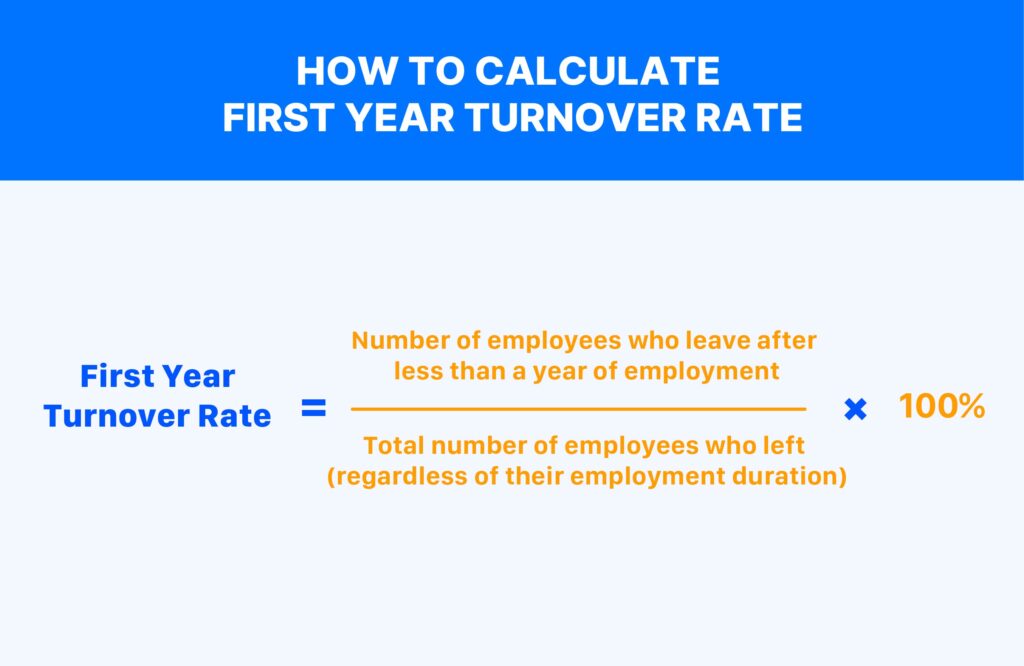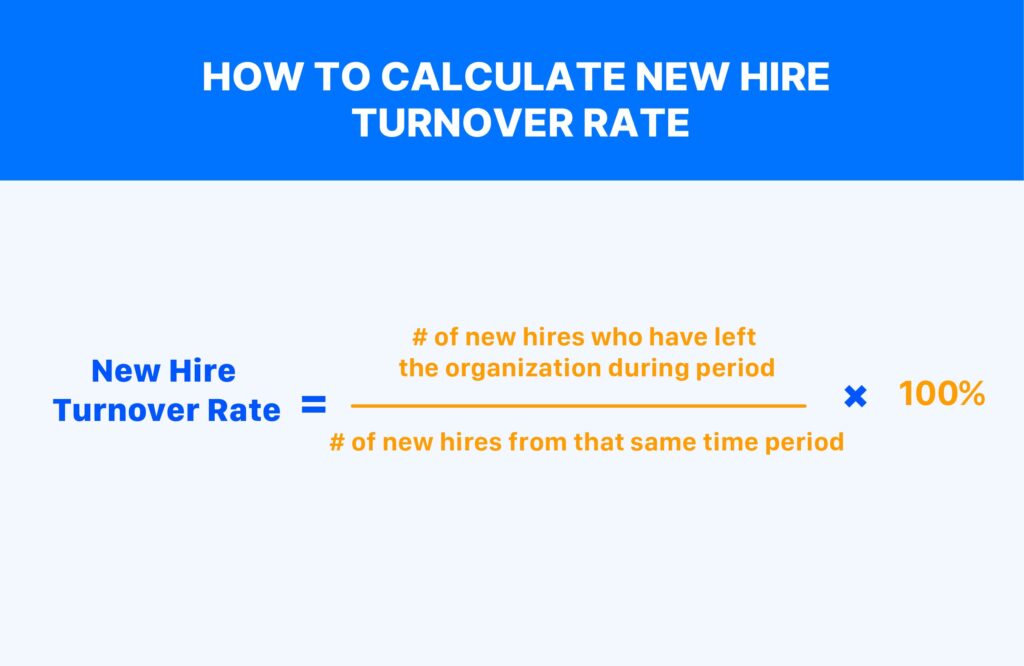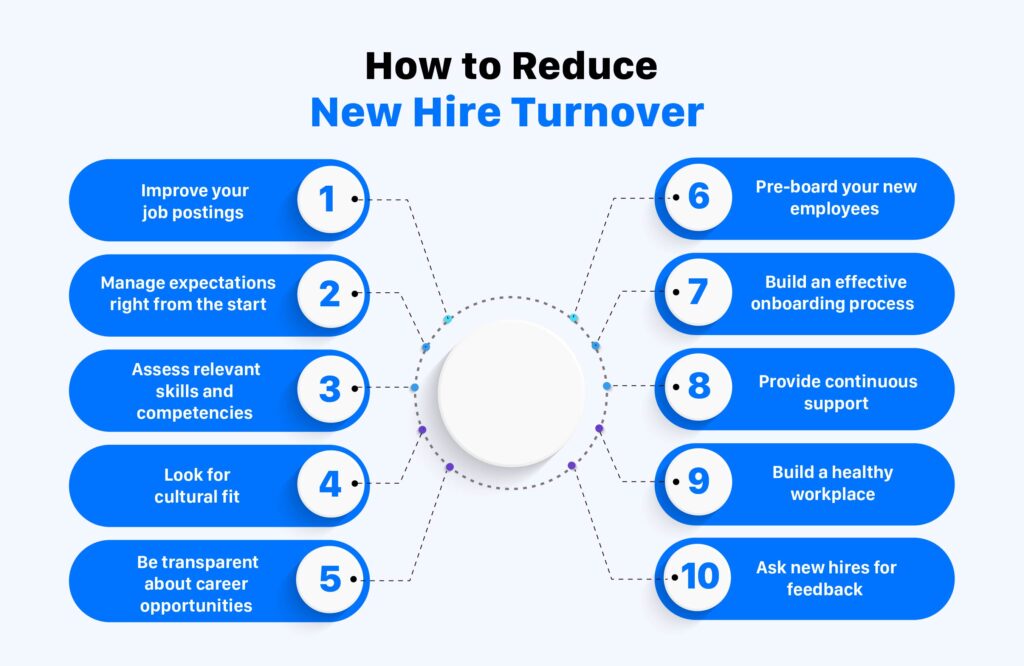Recruiting a new employee requires a significant investment of resources, including money, time, and manpower. Therefore, no company wants a new hire to leave prematurely. The hasty recruitment to fill vacancies is one of the causes of this problem. If possible, let’s try to slow down the recruitment process, similar to the “Hire slow – Fire fast” approach employed by large corporations worldwide, as extensively discussed by author Jim Collins in his book “Good to Great.”
In this article, freeC Asia will share with you about “New Hire Turnover rate,” also known as the first-year turnover rate. This is a rather pressing issue for businesses today, where new employees resign just as they are getting familiar with the job, leading to costs for new recruitment and training time. So how can we control this rate at the lowest possible level? Let’s take a closer look at the detailed article below.
What is New Hire Turnover?
New Hire Turnover, or first-year turnover rate, is a crucial metric in human resources and recruitment. This indicator is used to calculate the number of employees who leave within their first year or another timeframe determined by the company. New hire turnover can be voluntary (employees resign on their own) or involuntary (terminated).
The purpose of tracking new hire turnover is to assess the effectiveness of the recruitment process and new employee onboarding. Hiring a candidate who is not suitable for the job or company culture can lead to waste, not only in terms of money but also in terms of company resources. Furthermore, a high first-year turnover rate can severely impact employer branding, budget, and team morale, which is why we should closely monitor the new hire turnover rate.
Therefore, reducing the first-year turnover rate helps companies optimize costs and improve candidate attraction and experience.
Different companies have different time standards for determining the employee turnover rate after the first year. Typically, this period is one year.
Your company can shorten this period depending on your industry. For example, some sectors like hospitality have high employee turnover rates, so a shorter timeframe would be more suitable for calculating new hire turnover. Similarly, if your organization offers fixed-term employment contracts, you can reduce the timeframe for new employee departures to 180 days, 90 days, 60 days, or even 30 days.
Reasons Why New Employees Leave the Company
New employees resign for various reasons. While it’s impossible to predict or completely prevent them, new hires often leave companies due to the following groups of reasons:
Job Mismatch with Job Description
One of the most common reasons new employees quit is if the recruitment process and onboarding experience fail to accurately represent what their job will be like or create a sense of deception. New employees may feel misled and leave if they discover discrepancies in the job descriptions provided during the recruitment process, such as working hours, salary, benefits, or job duties.
Tip: Collaborating closely with the hiring manager to draft a careful and accurate job description is crucial to ensure that applicants clearly understand the job and their responsibilities. A good job description will outline specific tasks, required skills and experience, and other factors such as working hours, salary, and benefits. This way, we can minimize the risk of confusion and ensure that applicants are a good fit for the job and your organization.
Poor Management
“Employees don’t quit companies; they quit their bosses.”
If managers fail to properly onboard new employees and integrate them into their departments, it can quickly lead to feelings of isolation and unfair treatment. Too many managers have an unprofessional approach, negatively impacting productivity and morale throughout the company. Tip: Provide regular management training programs to equip your company’s leaders with the skills to empower their teams.
Inadequate Training for New Employees
When hiring a new employee, regardless of their previous experience, if the onboarding process doesn’t provide them with what they need to get familiar with the job, they may struggle to meet the company’s expectations. This can lead to new employees being ineffective and potentially terminated.
Tip: Utilize checklists to follow a structured onboarding process to help newcomers easily fulfill their responsibilities.
How to Calculate New Hire Turnover
There are two common ways to calculate new hire turnover. freeC Asia will explain each method and the specific formula in detail below:
New Hire Turnover as a Percentage of Total Employee Turnover
The first way to consider the new hire turnover rate is to indicate the percentage it represents within the total number of employee departures. In other words, new hire turnover is only considered a small part of the overall employee turnover. While this is a less common method for calculating new hire turnover, it can be a good reference indicator for organizations experiencing a large number of employee departures.
The formula for calculating this is as follows:

(*) You can adjust this formula to calculate new hire turnover based on a timeframe that suits your company (e.g., 30, 60, 90 days).
In this formula, “terminated employees” refers to employees or new hires who have left the organization, either voluntarily or involuntarily. In the Human Resources Information System (HRIS), this means their employment status changes from “active” to “inactive,” or they have a termination date on the system.
Suppose 10 people left your company last year. Of those, two were considered new employees with less than 1 year of service. The calculation would be as follows:
New Hire Turnover Rate = (2/10) x 100 = 20%
Among the two formulas mentioned, this is the less common version. However, for some organizations with very high new hire rates, this could be an indicator worth exploring. For this metric, new hire turnover is only seen as a subset of the overall turnover rate.
New Hire Turnover as a Percentage of Total New Hires
The second (and more common) way to calculate the new hire turnover rate is to calculate the percentage based on the total number of new hires.
The formula for this calculation is as follows:

The calculation of the new hire turnover rate will be based on data for a calendar year.
This means that if one out of 10 employees you hired resigned, the new hire turnover rate would be 10%.
New hires are those who have joined the organization within a certain period after being recruited. Depending on the business situation and the time required for employees to integrate effectively, a different timeframe can be chosen. High-turnover organizations might use a 30, 90, or 180-day range instead. Whichever timeframe is chosen, be consistent in the calculation method to allow for comparison between different periods.
Suppose you decide to choose a one-year timeframe for measurement. In the past year, 5 employees left the company after less than a year of employment. The total number of people hired in the past year was 20. The calculation would be:
New Hire Turnover Rate = 5/20 x 100% = 25%
This means that 1/4 of the company’s new employees left within their first year of employment.
How to Reduce New Hire Turnover
1. Improve Job Advertisements
One of the top reasons new hires leave organizations early is a mismatch between the initial job advertisement and the skills required as well as the tasks they are responsible for.
Before posting a job advertisement, ensure that the information and job description in your JD is accurate and transparent. Failure to do so can lead to underqualified or overqualified candidates applying for the position and a decline in morale when they start the new position and it does not meet their expectations.
Hiring managers and the HR department should work closely together to create a clear list of responsibilities and tasks, required skill levels, and information about the company culture. If possible, you might consider creating a “day in the life at the office” video so candidates can better understand what their job would be like.
In case of using headhunting services, leverage this resource so that they (professional recruitment consultants) can advise and provide reasonable and appropriate adjustments to the positions that need to be filled. These headhunting experts have a considerable amount of knowledge and experience that can assist you in creating job advertisements with accurate job descriptions for each position.
2. Manage Expectations from the Start
According to a study by HRDive, 48% of employees leave companies because the job is not what they expected. Managing employee expectations is a proven way to reduce employee turnover rates. Doing this is not difficult at all.
Find ways to communicate both the positive and negative aspects of the new position and role throughout the recruitment process (mentioning it in the job advertisement and during interviews).
One effective way is to conduct quick interviews with current employees working in the same position or department to share honestly about the successes and challenges of the job. You might consider filming videos of important tasks that employees perform in a week or a month. Then, compile them into a video for candidates to watch so they can visualize what this new position would be like.
3. Assess Relevant Skills and Abilities
How can you ensure that new hires will have the right skills and abilities to take on their jobs? Resumes can provide information about a candidate’s background, but relying solely on them is not enough. To ensure the right candidates, combine aptitude and personality tests. In other words, thorough testing during the selection process will provide more information about the candidate and whether they are suitable for the position.
If you’re unsure which tests to use due to the position being newly recruited or specific positions requiring highly specialized tests, headhunting services could be a good option to consider. They offer an effective means of reaching candidates with the appropriate skills and experience, thereby minimizing the risk of errors during the recruitment process. This is especially important in industries that require extensive knowledge or specific skills, where finding the right candidates can be complex and time-consuming. Headhunting services help optimize this process by screening and identifying the most potential candidates, ensuring that you get the right person for your specific job.
4. Seek Cultural Fit
To assess whether a candidate fits the company culture, it’s crucial to understand your organizational culture and the type of employees you want to attract. Company culture significantly influences how employees adapt and integrate into the new work environment and their teams. Cultural fit doesn’t mean you want to find someone to “have beers with after work.” Rather, it’s about finding people who align with the company’s values and culture regarding behaviors, work styles, and more.
In practice, this means that during the recruitment process, you need to assess behaviors and values that fit with your current team or the new culture you are trying to create.
One way to do this is to encourage employee referrals through a “Referral Program.” For example, offer bonuses or valuable gifts to employees for each successful referral they make. Asking behavioral and teamwork-related questions during interviews is also a common way to better understand a candidate’s personality.
5. Transparency about Advancement and Career Opportunities
One of the leading reasons for high new hire turnover rates is the lack of career development. If a company does not support personal career goals and has no clear career path, it’s only a matter of time before employees move to a company that does.
Therefore, being clear about career development during the recruitment process is essential. If it’s an independent position with limited opportunities for career advancement, be upfront about this from the beginning.
Similarly, if your organization can offer career development, managers must help employees understand how they are performing and areas for improvement to advance their careers. They should inform employees about any internal transfer or career development opportunities, always provide training, and support their growth.
6. Pre-Onboarding Preparation for Employees
A creative and engaging pre-onboarding phase will get new employees excited about their new roles before their first day of work. Most companies will hand out a rather boring employee handbook or required attire, and that’s where it ends.
But we can do much more to differentiate our company from competitors and make a good impression on new employees. You might consider sending a welcome video, some company gifts, or even a personal message from their manager. By doing so, we’re building a memorable employee experience right from the start.
7. Build an Effective Onboarding Process
By designing an effective onboarding process, businesses can help new employees settle into their roles and integrate with the company quickly. Here are some tips to enhance the new employee onboarding experience:
- Give newcomers a warm welcome.
- Prepare their workspace before they arrive.
- Ensure new hires have the equipment they need.
- Automate HR processes.
- Schedule teambuilding activities in advance.
- Pair them with a buddy to help them integrate quickly during the first few weeks or months.
A well-organized onboarding program ensures new hires can optimize their time to get familiar with their new position and build connections with their team. This has a positive impact on your organization’s new hire retention rate.
8. Continuous Support
Supporting new employees shouldn’t stop after the onboarding process. The HR team should continue to check in with new employees to ensure they have what they need to perform effectively in their new roles and are adapting well to the environment.
Ensure managers assign meaningful tasks and responsibilities with moderate pressure from engaging projects. Be proactive in providing necessary guidance, offering constructive feedback and praise to boost new employees’ confidence, discussing career goals, and having regular meetings.
9. Build a Healthy Work Environment
An environment with an open and diverse culture is crucial to ensure that new employees feel comfortable, welcome, and want to stay. Small things like rude managers and political cliques in the office can negatively impact your work environment.
Additionally, offer attractive benefits and rewards to your employees. Benefits such as flexible working hours, health insurance, vouchers or gifts, or time off on their birthdays are all popular and can make your employees more productive, happy, and engaged in their work.
10. Feedback from New Employees
One important aspect is feedback from new employees, whether proactive or not, including both current and departing employees. A survey or a short meeting where employees are encouraged to be open and honest can help you better understand what is working and what is not so you can improve and adjust accordingly.
Why is New Hire Turnover Important?
Seeing new employees leave early for valid reasons is a cause for concern. This can impact your organization in several aspects:
- Employer Brand: New employees abruptly leaving the company out of frustration can create multiple issues that need to be addressed. These individuals tend to leave negative reviews on social media platforms (Facebook, Google, Glassdoor, etc.), making qualified candidates think twice before applying to your company.
- Recruitment Budget: Employee turnover issues significantly affect the recruitment budget. Every time an employee leaves, we spend more than expected on recruitment, not to mention the hidden costs that freeC has previously mentioned in the article on Time-to-Hire.
- Team Balance: New hire turnover impacts your team by leaving gaps and shortages in personnel.
This requires time to recruit and train new employees, not to mention the increased costs associated with being understaffed. These changes can affect team productivity and morale.
In reality, there’s no need for grand promises to enhance employee loyalty. We simply need to be consistent in our actions and words. Ensure the job aligns with what you described during the recruitment process, and develop a positive work environment for your employees.

How Headhunting Services Impact New Hire Turnover
Headhunting services can affect new hire turnover rates in several ways:
- Candidate Quality: Candidates recruited by headhunting firms may be of higher quality, possessing the necessary skills and experience for the role. This can lead to better job satisfaction and lower new employee replacement rates. At freeC Asia, with a “data pool” of over 550,000 carefully screened candidates, we can provide you with quality candidates to meet any position.
- Cultural Fit: Headhunting firms often consider the cultural fit aspect when searching for candidates for their client companies. If candidates fit well with the company’s culture, they are more likely to stay long-term, reducing turnover rates.
- Recruitment Process Efficiency: At freeC Asia, the recruitment process is optimized through an AI-powered system, from storing, screening, and searching for quality candidates to delivering them to clients quickly within 3-5 days. This efficiency can lead to faster hiring, reducing the likelihood of candidates dropping out during a lengthy recruitment process.
- Negotiating Terms: Headhunters have extensive experience negotiating competitive salary and benefits packages on behalf of candidates. When new hires feel adequately compensated and valued, they are less likely to leave for better opportunities elsewhere.
- Ongoing Support: Some headhunting firms provide ongoing support to both candidates and companies after the hiring process. This support can include assistance with onboarding, performance evaluations, and resolving any issues that arise, helping to increase employee retention rates.
Contact us for a FREE consultation today to learn more about how freeC Asia’s headhunting services can help your company reduce new hire turnover throughout its operations.
Bài viết How to Calculate and Reduce New Hire Turnover Rate? đã xuất hiện đầu tiên vào ngày FreeC Blog.
source https://blog.freec.asia/how-to-calculate-and-reduce-new-hire-turnover-rate/
Comments
Post a Comment